Transitioning from beach volleyball to indoor volleyball, or vice versa, is not as easy as just jumping on a different type of volleyball court. Not only do the courts and conditions change, but the rules change as well. Heck, even the equipment changes!
Your most valuable time is spent creating muscle memory and not wasting hours trying to figure out the rule differences. For your convenience, here is a list of rule variations between indoor and beach volleyball.
Court rules
Court surface and size
The court size is quite a bit smaller in sand volleyball and rightfully so. Because the sand makes it harder to get to the ball, the court is only 16 x 8m, as opposed to the 18 x 9m of an indoor court. Beach volleyball must have at least 3m of free zone, whereas indoor can suffice at 2m but is recommended for 3m.
A beach volleyball court is clearly made of sand and must be level and free of rocks, shells, or anything else that could cut the feet of the players. The indoor courts also must be flat, horizontal and uniform but are clearly not made of sand.
There should be 7m, or 23 feet, of overhead clearance for beach volleyball and 7.01m of overhead clearance for nationally recognized indoor volleyball competitions.
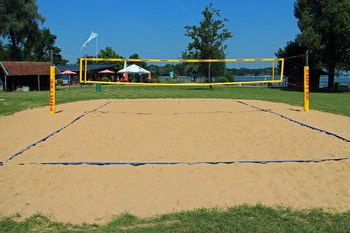
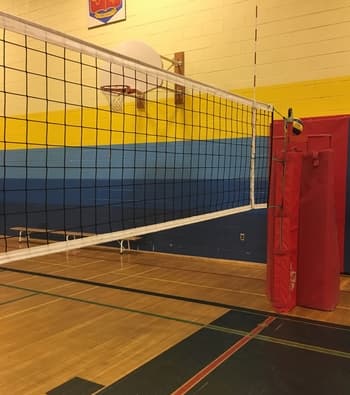
Lines on the court
Lines indoor should be 5cm or 2” wide whereas beach volleyball starts with 5cm but can go up to 8cm. Both state the color must contrast with the court. Beach volleyball gives the option of using rope lines which can be thinner, 0.5 to 1cm wide.
There is a centerline for indoor volleyball where no centerline is used for beach. The same falls for attack lines, whereas there is an attack line for nationally recognized competitions for indoor.
Finally, this is a unique rule for beach volleyball. The lines can move. Obviously in indoor volleyball, a line is painted on the court and will not move but with beach, it is possible a line could be hit with a foot causing it to move. Likewise, an anchor holding a line could be pulled out, causing line movement.
If the anchor and line are actually pulled out and with it, the court changes significantly, the play will be stopped and started over. If a line simply moves during the play, the line will be replaced after the end of the play. Because it is sand and a ball will make a mark when hitting the sand, if a ball were to go out close to where the line should have been, the ref will look at the ball mark and the line and determine if the ball was in or out.
Nets
Indoor volleyball does not specify anything regarding markings on the net; however, beach volleyball allows advertising on the top, bottom and side tape or bands.
The band at the top of the net should be 5.08 to 6.99 cm for indoor volleyball. Beach volleyball states the band should be 7 to 10 cm wide.
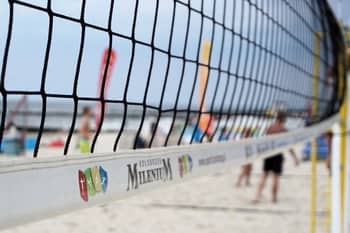
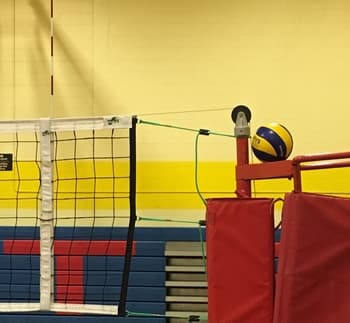
The net post for indoor must be 0.5 to 1m from the sideline as opposed to beach volleyball, where the range is a bit smaller, 0.7 to 1m from the sideline. The posts for beach are also recommended to be rounded and smooth and free from sharp edges. Since beach volleyball is played barefoot, it makes sense that the posts would be recommended to be in a way that no possible cuts could happen.
Team Members
Captains
For both indoor and beach, one team member is designated the captain. For indoor, this person cannot be the Libero and is captain while on the court. If the team member is not on the court, someone else must be designated the floor captain. For beach volleyball, only the captain is authorized to speak to the referee and must wait until the ball is out of play.
Number of players
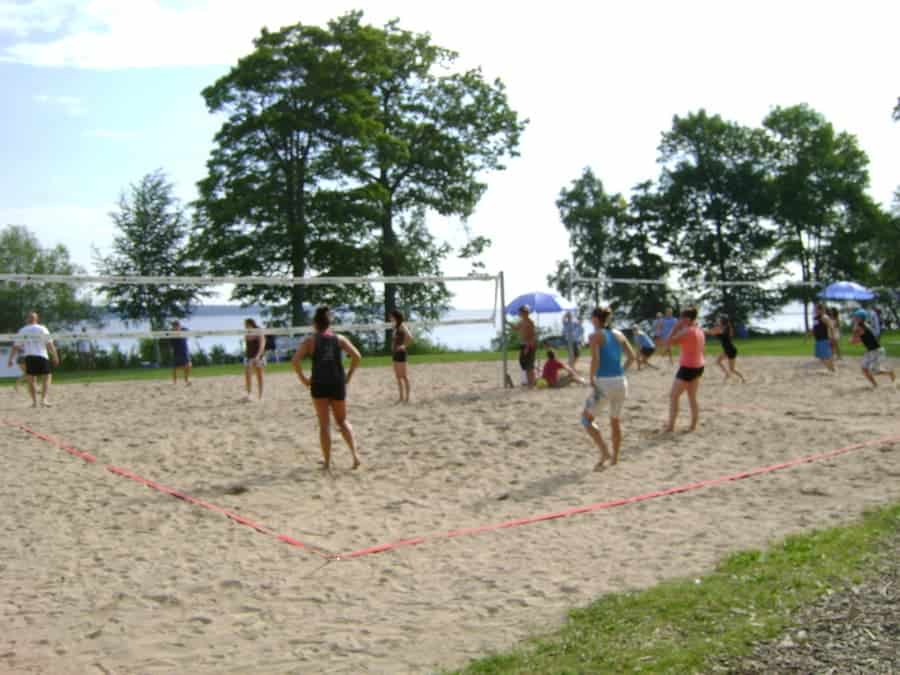
Indoor has a cap of 15 players and five coaches, although only six play at one time and the team must have six to play.
Competitive beach volleyball is comprised of two players and they may have a coach and an assistant coach. However, recreational beach volleyball leagues can include 2s, 3s, 4s, or 6s.
Player positions
Indoor volleyball includes specialized player positions, players need to rotate in a certain order, and has strict rules about the differences between front and back court players.
For example, a player who is in the back court can’t move past the attack line when they are attacking the ball. Examples of specialized player positions include middle hitter, left-side hitter, right-side hitter, setter, and libero.
Rotation rules means that every time the server changes, players must move clockwise into a new position on the court.
Related article: A Simple Guide to Volleyball Positions and Rotation
In beach volleyball, there are no rules about player positions, rotating after each serve, and there is no attack line to distinguish between front and back court players when playing with 2, 3, or 4 people teams. The only exception is that players always need to follow a serving order, regardless of how many people of the team.
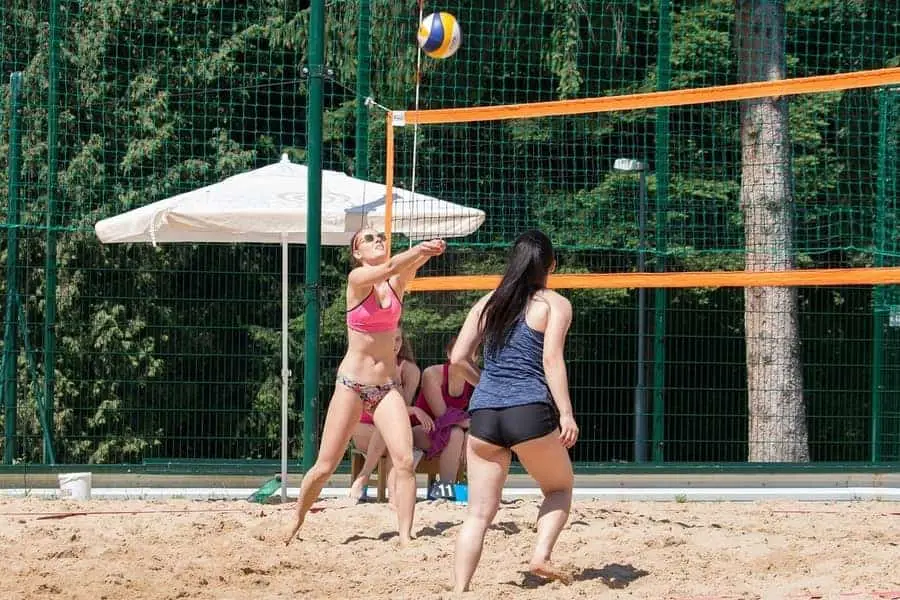
This means that all players can play any type of position during the game. In fact, it’s important for beach volleyball players to have a strong foundation of all the volleyball skills, since they will be touching the ball much more often.
Related article: 7 Basic Volleyball Skills for Beginners
When playing beach volleyball with a 6 person team, the same rules as indoor apply for player positions, rotation, and front/back row attacks.
Coaches
The allowances the coaches have are pretty different in beach and indoor volleyball. For starters, beach volleyball states that no coaching is allowed at all when the ball is in play. The coaches must be seated in the players area except during timeout, between sets or switching sides and this is the only time they can coach. You even cannot coach between rallies.
Beach volleyball is even more specific stating all coaches must be identified as such and dress professionally. The bare minimum they can wear is a shirt and shorts. They cannot address officials at all and may only instruct from the sideline during warmup. They can perform drills with their team on the court prior to the official warm up time but must then leave the court when warm up starts.
Indoor volleyball is not nearly as strict on the coaches’ side. They must be designated and on a roster. Only the coach may intervene in a match, not the assistant. If the coach is seated, he or she must sit on a bench and be the team member closest to the scorekeeper. The coach is allowed to stand or walk in the free zone in front of the team bench, at least 1.75m away from court, and only one assistant coach may stand to coach.
Ball Handling
Block counts as a contact in beach
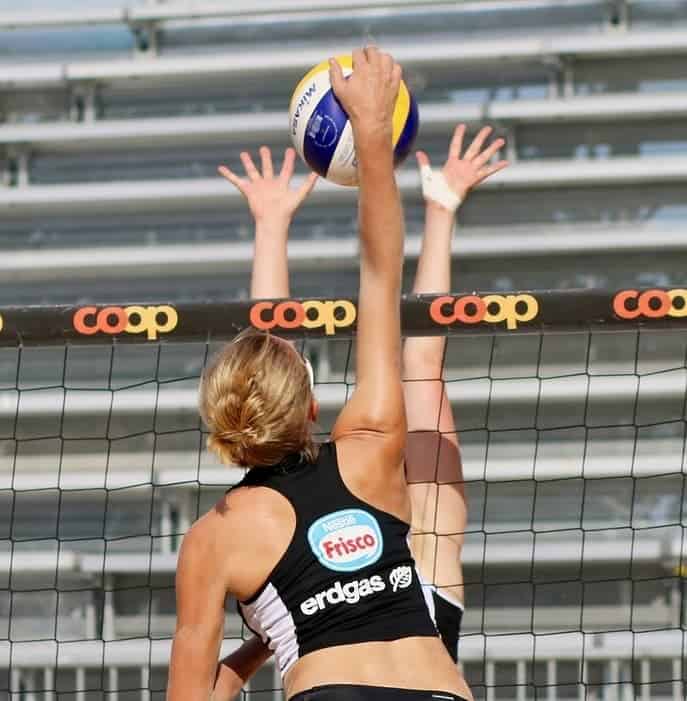
One of the basic rules of volleyball is that each team can only contact the ball 3 times before it has to go back over the net to the opposing team. In indoor, a block does NOT count as a hit. This means that a team can block the ball, then still pass, set, and hit it back over.
However, in beach volleyball, the block DOES count as a contact. This means that if a team blocks the ball, they now have only 2 touches to get the ball back over the net.
Volleying the first ball touch
Many people will forearm pass (or bump) the ball when it’s being served or hit over the net to them. However, many people will also volley or use their flattened hands to pass the ball up. This is allowed in both indoor and beach volleyball, however the difference is that in indoor volleyball, there is a bit of leniency in the quality of the first touch. In other words, many officials will let some less-than-perfect ball touches go when it’s off a hard-driven serve or hit.
However, in beach, that first contact has to be absolutely clean. That is, there can be no spin, no double-hitting, and absolutely no lifting. As you can imagine, this is pretty near impossible! The best option is to just forearm pass as much as possible.
Setting the ball over the net
In beach volleyball, a player must be perpendicular to the net (in other words, either totally facing it or with their back totally to the net) when they’re setting the ball over the net. The only exception to this is if they are trying to set their partner up for a hit and the ball is accidently blown over the net by the wind.
In indoor volleyball, there is no rule stating that a ball cannot be set over the net.
No tipping in beach
If you’re an indoor player making the transition to beach, one of the biggest rules to get used to is that there’s no tipping in beach volleyball. While a tip is considered a strategic form of attack in indoor volleyball, in beach it’s considered an unfair attack when there are usually only 2 people to cover the whole court.
Instead of tipping, acceptable ways of attacking the ball over the beach net include: using the palm or heel of your hand, hitting the ball with the tips of your locked, straight fingers, or knuckling the ball. These alternatives take quite a bit of practice, so try to practice before playing in any formal games or tournaments. On the plus side, once you master these tipping alternatives, you’ll increase your attacking options for your indoor game!
Uniforms
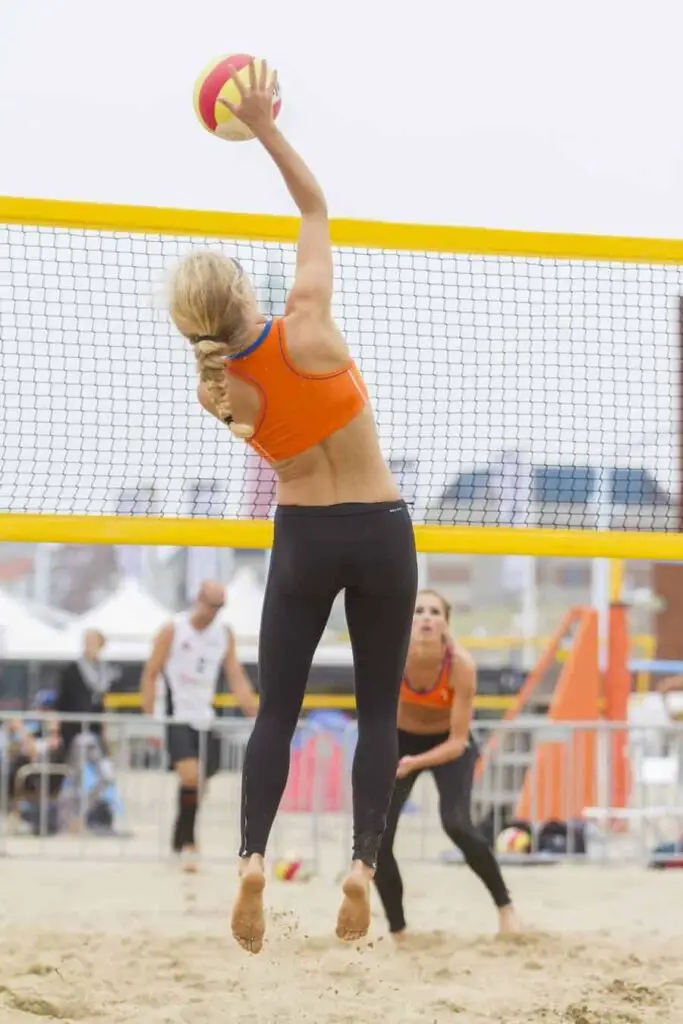
As expected, there are differences in the rules for the uniforms but one point remains consistent: a player is not allowed to compete until any uniform violations are corrected.
Clearly, playing in the blazing heat as opposed to an air-conditioned gym yield different uniforms. Beach volleyball allows for a uniform consisting of shorts or a bathing suit. Check any tournament regulations for specifics on tank tops or jerseys. Hats, visors, or sunglasses are allowed.
For indoor competitions, all players must dress alike including any visible undergarments. The only exception to this is the Libero, who should not be dressed like the other teammates.
Numbers on uniforms
Beach volleyball does not require numbers. If they are used, they should be on the chest or the front of the shorts. Only 1 and 2 may be used.
Indoor volleyball requires that uniforms be visible and centered horizontally and vertically on the player’s chest and upper back.
Jewelry
During play and warmups, beach volleyball does not allow any object that may cause an injury or give advantage to a team. They allow for glasses but state that it is at the player’s own risk.
Related article: Is wearing jewelry in volleyball against the rules?
For indoor junior competitions, referees are to ask during warmups that competitors remove all jewelry and that during adult competitions, they remove any jewelry that could cause an injury. For junior competitions, if the jewelry is of a religious nature, it may be sewn or taped under the uniform.
Blood
For both indoor and beach volleyball, blood on the uniform results in being asked to change the uniform and given time to do so. For indoor volleyball, care needs to be given to ensure that there are no duplicated numbers on the roster post uniform change.
Sanctions
Like many sports, both beach and indoor volleyball utilize red and yellow cards. Because beach volleyball has only two players on their team, whereas indoor can have many more, the penalties of a sanction can vary. For indoor, team players can substitute in and therefore many sanctions last for the duration of the match. For beach volleyball and only two players, many sanctions last only for the set.
Types of sanctions
Warning
Beach volleyball has one type of warning and that is a yellow card. A team may only receive one yellow card per set (note: set, not match). In indoor volleyball, there are two stages of warnings. Stage 1, no card is shown and it is simply relayed through the team captain. Stage two is a yellow card which indicates all team members have reached the sanctioning level and will be held there for the entire match.
Penalty
This is signified in both by a red card. For beach volleyball, a player may receive two red cards in the same set but a third red card will cause the player to be expelled. Expulsion in beach volleyball means that the set is defaulted because there are now not enough players to complete the set. A red card in beach volleyball also means that a point and serve are both given to the opposite team. For indoor volleyball, no penalty points are given.
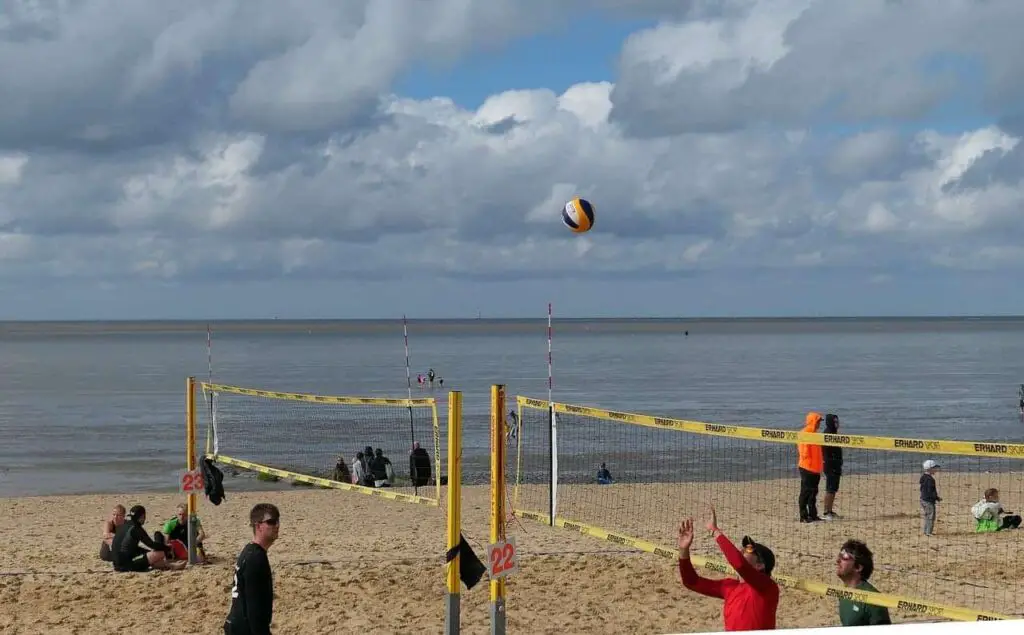
Expulsion
For both beach and indoor volleyball, expulsion is indicated by red and yellow cards being held up in one hand. As mentioned above, for beach volleyball this results in the set being forfeited.
During indoor volleyball, if there is a penalty area, the teammate who is expelled must sit there for the rest of the set. If there isn’t a penalty area, they simply remain on the bench. If multiple team members are expelled, they must leave the playing areas, including warm up areas
Disqualification
This is the final stage of sanctions and is signaled with a red and yellow card being held up and apart in separate hands. For beach volleyball, the match is now forfeited. In indoor volleyball, the team members who are disqualified must leave all playing areas, including warm up areas, and also any spectator areas for the remainder of the current match.
Acknowledging a sanction
In beach volleyball, to acknowledge a sanction, you do just that. You acknowledge the sanction. The procedures for acknowledging a sanction for indoor are a bit more cumbersome and rely heavily on the captain.
If you are on the court and you receive a sanction, you come to the referee’s stand to acknowledge it. If on the bench, the game captain goes to the referee stand to get the information and then goes to the offending member, who raises a hand to acknowledge the sanction.
If the sanction is due to a delay or improper request, the captain goes to the referee stand to get the explanation. The captain or a second referee explains to the coach, as needed and without delaying the game.
The first referee in the game will also blow a whistle when giving a sanction.
Timeouts
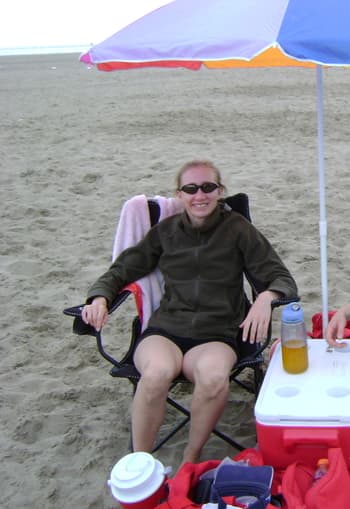
The big difference in timeouts between beach and indoor volleyball is with beach volleyball, only the captain can make the request. A coach cannot. During indoor volleyball, the coach or captain can make the request but the coach must be in the bench area or warm up area to make this request.
Teams are not required to leave the courts during timeout but with indoor, if the team does not leave the court, the coaches and other non-playing team members cannot go onto the court during the timeout.
A timeout can end early for beach volleyball if the teams are ready but not for indoor. The length of time for a timeout is 30 seconds; however, in beach volleyball the players are given 15 seconds to get to the players box and then another 15 seconds for the game to resume following the timeout. A whistle indicates when the 30 seconds is over for beach volleyball.
A timeout can end early for beach volleyball if the teams are ready but not for indoor. The length of time for a timeout is 30 seconds; however, in beach volleyball the players are given 15 seconds to get to the players box and then another 15 seconds for the game to resume following the timeout. A whistle indicates when the 30 seconds is over for beach volleyball.
During a timeout, indoor volleyball does not allow a ball to be used. Beach volleyball does allow a ball to be used in all areas of the court during all intervals of a match including not just timeouts but also in between sets.
Related article: Volleyball Timeout Strategies: When to Call It and What to Say
Lineup changes
Lineups cannot change for beach volleyball, as there are only two players. For indoor, they change by substitution. The lineups are due following the coin toss, which captains must attend. For beach volleyball, the captains determine if they receive or serve first. For indoor, the lineup is due two minutes before the end of the timed warmup.
Warmup
The warmup procedures vary greatly for indoor versus outdoor volleyball. For indoor, default is given to the tournament rules. Broadly, for junior competitions, only one team can be on the court warming up at a time and the other team must be at its own bench or at least out of the playing area. The team waiting to warm up may not use balls to warm up at the bench or spectator hallways. For adult competition, shared hitting and serving are often allowed.
For beach volleyball, there is a more set procedure. If the teams were able to warm up on another court, they will have 3 minutes of shared warm up time within a total of a 5 minute warmup. If they did not have this warm up period, they will have 10 minutes total of warmup, with 5 being shared.
During play
Service toss
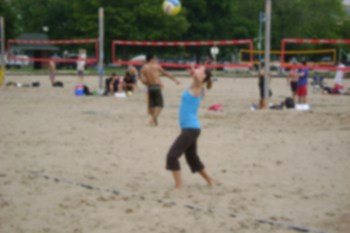
The major difference between beach and indoor for the toss before the serve is that beach volleyball allows for 5 seconds for contact and indoor allows for 8 seconds. For 14 and under divisions, there can be two tosses for indoor with 5 seconds allows for each.
Switching sides
In indoor volleyball, each team stays on their side of the net during the entire set. Teams then switch courts at the end of each set. The only time teams switch sides during a set is when the game is being played to 15 points; then, teams will switch when the first team reaches 8 points.
In beach volleyball, because wind, sun, and other outdoor factors can cause distractions during rallies, teams switch sides during the set. If a game is being played by rally point to 21, teams switch sides when the sum of the teams’ score equals a multiple of 7. For example, when the score is 3-4, 8-6, or 12-16. If the game is being played to 15 points, then teams switch on multiples of 5 (examples: 2-3, 7-3, or 10-15)
Hitting the ball from an opponent’s free zone
In beach volleyball, a player may enter into an opponent’s court or free zone to retrieve the ball, assuming it does not interfere with the opponents play. In indoor volleyball, the rules specify that if after the first hit, the ball goes to an opponent’s free zone (does not mention court), the ball may be retrieved as long as no center line fault occurs and the return path of the ball must be over or outside the antenna.
Net contact
Touching the net in either beach or indoor volleyball is not allowed and results in losing the rally. Beach volleyball takes an additional step in spelling out what it considered player interference:
- Touching the top band of the net during the action of playing the ball
- Taking support from the net while playing the ball
- Creating an advantage while touching the net
- Making actions that limit an opponent attempt to play the ball
- Contacting an opponent through the net during the action of the ball
Crossing the center line
In beach volleyball, it is fine for a player to enter into their opponent’s space, court or free zone. However, they cannot interfere with their opponent’s play while doing so.
In indoor, the hands or feet may enter into an opponent’s space but some part of the body must be on or above the center line and must not create a hazard or interfere with the opponent’s play.
Retrieving a ball in the free zone
A ball that goes out of the free zone may be retrieved in both indoor and beach volleyball if the area is free of obstructions or interference; however, for indoor, the area past the free zone must not have a surface area of anything more than ½ inch. If that does not exist, then the player must be touching the playable area.
In beach volleyball, retrieving this ball must not cause the player to enter an adjacent court and it is often recommended that banners mark where free zones are located to help with this.
Extras
Weather
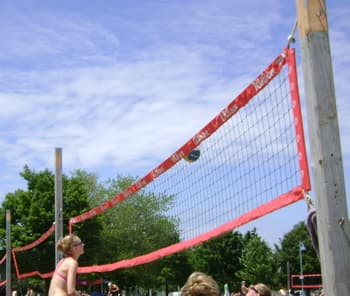
As expected, with beach volleyball, the weather must not present any danger to the players. For example, beach volleyball games will be postponed during a lightning storm.
With indoor volleyball, the temperature must be at least 10 degree Centigrade or 50-degrees Fahrenheit. Beach volleyball tournament directors and head referee will determine if the lighting is sufficient for a match. Indoor volleyball simply needs 300 lux.
Ball
The indoor volleyball ball must be uniform in color and can be light colors or a combination of colors. The ball should weigh 0.3-.325kg/cm2.
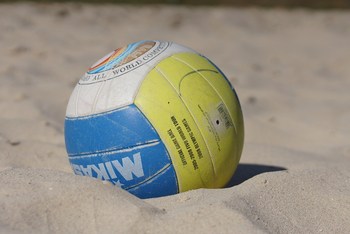
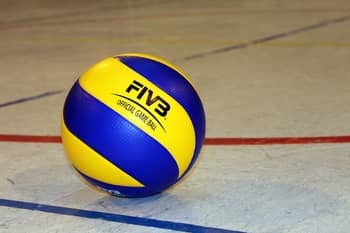
The beach volleyball specifies a bit more, stating that the material used for the ball should be flexible and not absorb humidity or moisture. This is important – could you imagine the ball absorbing moisture and getting heavier in weigh during a humid match? If multiple balls are used, the colors must also be uniform or a combination of colors. The beach volleyball weighs 0.175 – 0.225 kg/cm2.
Related article: What Volleyball Should I Buy?
Failure to report on time between sets
For whatever reason, a team may fail to report on time in between sets. For beach volleyball, this results in a delay warning or potential penalty. For indoor volleyball, this failure can result in a default in the match.
During beach volleyball, the interval in between the sets begins at the referees “end of set” signal, whereas in indoor volleyball, this starts when the referee awards the final point of the set.
Conclusion
As you can see, there are numerous rules that differ between the two playing courts. Most rules are not groundbreaking but logical given the differences in environment. Allow yourself grace and patience when moving from one season to the next to freshen up on your rules and form new muscle memory. Remember, you play because you love the game. Don’t let the changes in the rules trip you up so much you forget why you are on the court.

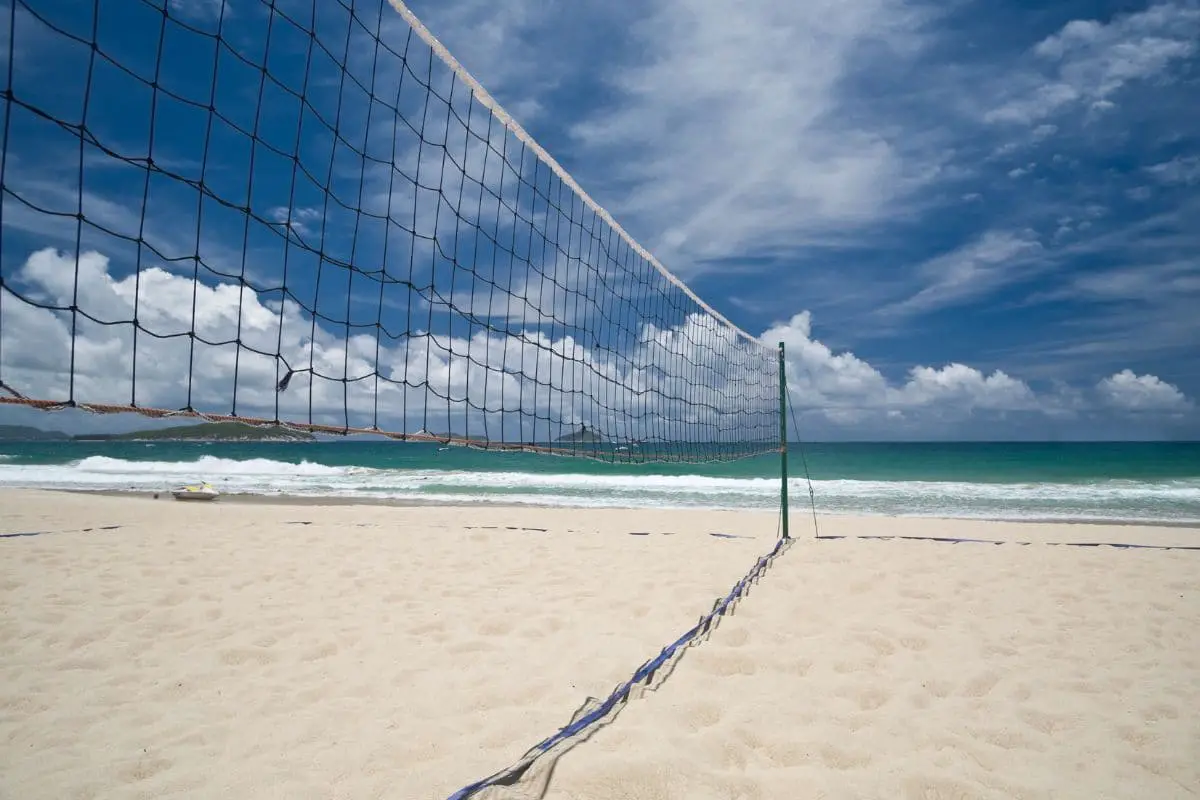
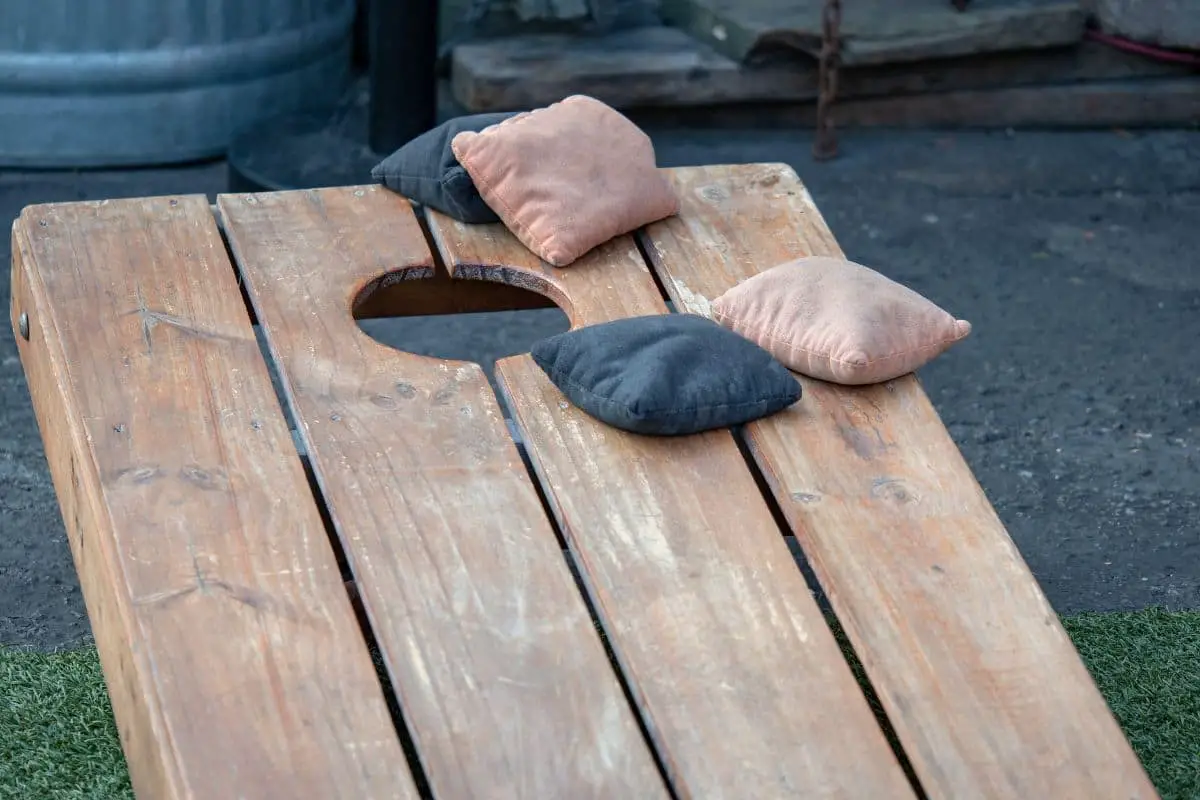
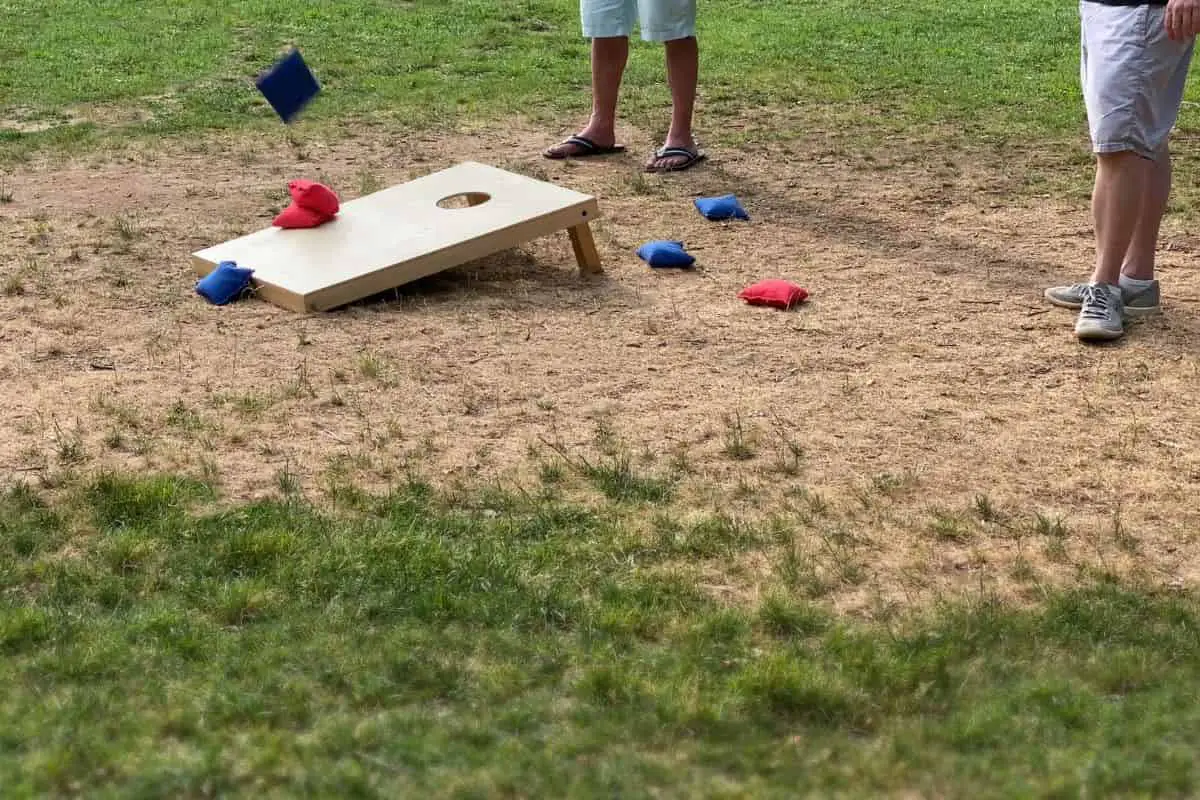
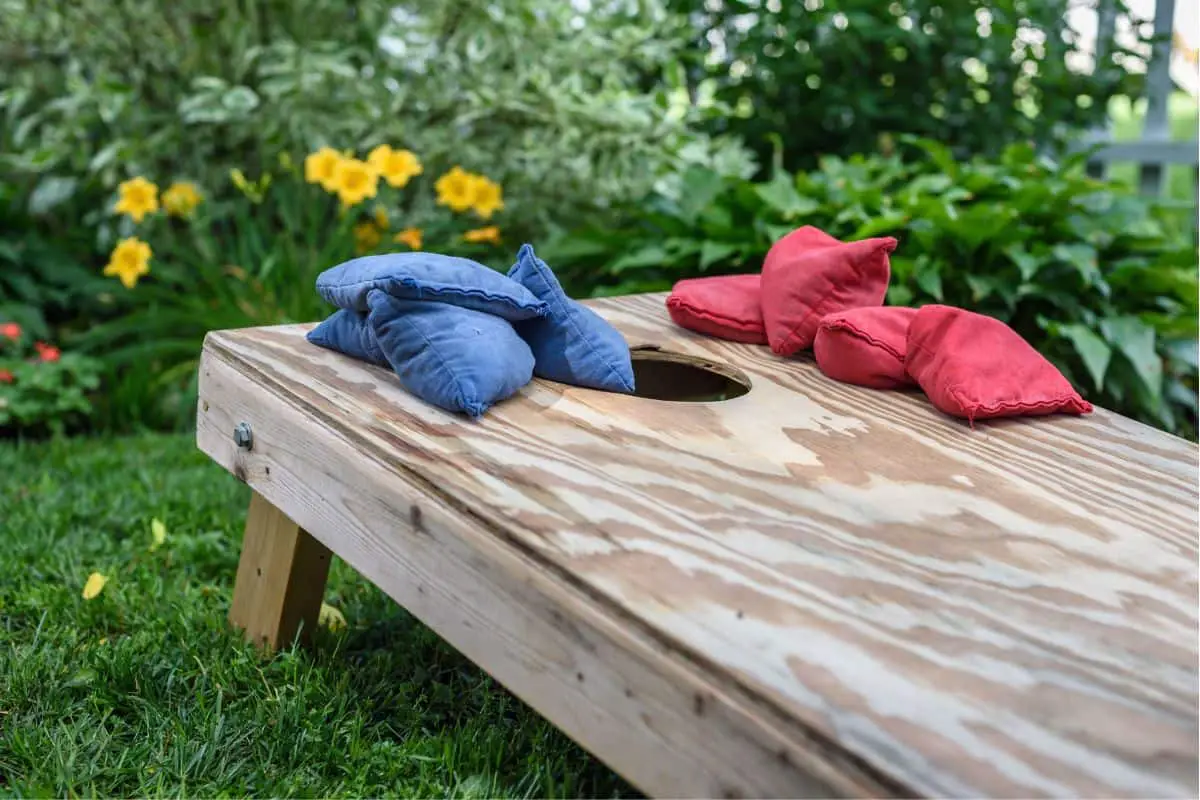
Leave a Reply
You must be logged in to post a comment.